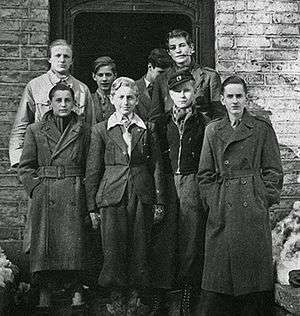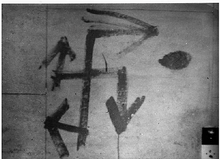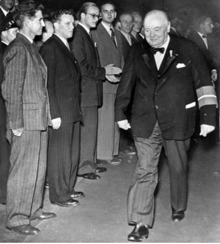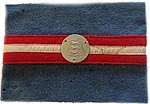Churchill Club
The Churchill Club (Danish: Churchill-klubben) was a group of eight teenage schoolboys from Aalborg Cathedral School in the north of Jutland who performed acts of sabotage against the Germans during the occupation of Denmark in the Second World War.
| The Churchill Club | |
|---|---|
Churchill-klubben Participant in World War II | |
 The early Churchill Club and friends in front of their monastery. Back row (left to right): Eigil, Helge, Jens, Knud. Front row (left to right): unknown, Børge, unknown, Mogens F. | |
| Active | 1941-1945 |
| Leaders | Knud Pedersen |
| Headquarters | Hospital of The Holy Ghost, Aalborg |
| Area of operations | Aalborg, Denmark and surrounding cities |
| Size | 8 |
| Part of | Danish resistance movement |
| Allies | RAF club |
| Opponent(s) | |
The Churchill Club was one of the earliest resistance group to be formed in Denmark. Under the leadership of 15-year-old Knud Pedersen, their activities began at the end of 1941 when they began to target the German occupation forces in Aalborg to imitate the resistance of Norwegian soldiers. They succeeded in carrying out 25 acts of sabotage before they were arrested by the police in May 1942.[1] Some of those acts of sabotage included stealing weapons and destroying vehicles, blueprints, and plane parts. The boys were charged with 1,860 million kroner for the destroyed Nazi property; their sentences ranged from two to three years in prison. Even after imprisonment, they managed to escape at night to continue their sabotage activities.[2]
The RAF Club
On April 9, 1940 the German Army invaded Denmark with little resistance. 14-year old Knud Peterson and his Family saw the horrific acts of violence the German troops committed against their people. Knud, along with his friends and family, started a small resistance group in Odense, Denmark. They named themselves the RAF after the British Royal Air Force because of the high level of respect they had for them. They started with small acts of sabotage such as cutting phone lines of German Military Headquarters. They performed these small acts through the summer and fall of 1940. In April 1941, Pedersen moved to Aalborg, forming the Churchill Club there. Meanwhile, the RAF Club stayed active and eventually was in friendly competition with the Churchill Club.
Formation of the Churchill Club
In the spring of 1941, Knud Petersons and his family moved 150 miles north to Aalborg, Denmark. It wasn't until a few days before Christmas of 1941 when Knud wanted to bring the rebellious acts from Odense to Aalborg. Knud and his friends called themselves the Churchill Club after Prime Minister of United Kingdom Winston Churchill. They performed their acts of sabotage in the daylight using their bicycles as their form of transportation. They acted in the daytime because at night everything was guarded more heavily. One of their main acts of resistance was painting their symbol on street signs and on the homes and offices of Nazi soldiers. One of their first acts of sabotage was painting the words “War Profiteer” on the homes and offices of Nazi soldiers in blue paint.
Symbol
The symbol of the Churchill Club imitated the Nazi swastika, it was blue with arrows at the end of each line. The symbol stood for “Flames of Rebellion!”

Acts of Sabotage
In February 1942, the boys of the Churchill Club devised a plan to raid the Fuchs Construction offices at Aalborg airport. The Fuchs construction company was a local company paid by the German Army to build hangars and runways. They surreptitiously made their way to its offices and set a fire inside the main office. The building did not burn down but it was their first large scale sabotage.
The Churchill Club always took the opportunity to destroy German vehicles.
The Churchill Club would patrol the town on a regular basis and take any opportunity to steal the German's guns. They never used the guns but they would stockpile them and turn them into homemade explosives for sabotage missions.
On May 2, 1942 the Churchill Club blew up the Aalborg railroad yard, which was the town's main Nazi base. The railroad cart that they blew up contained an airplane wing. The Danish fireman were slow to help the Nazis because of a fear of more explosives. This was one of their most successful attacks.
Arrest and Trial
May 8, 1942 witnesses saw two members of the Churchill Club enter a cafe and steal a weapon from a soldier's coat. Witnesses identified the two boys outside their private school. Later that night, Knud was arrested and the Germans took their stockpile of stolen weapons. Everyone who was involved was arrested that night. They were sent to Aalborg State Prison with sentences ranging from 6 months to 3 years. In October 1942, a few boys managed to escape for 19 consecutive nights and perform more acts of sabotage. After the boys were recaptured, attacks from the Churchill Club ceased.
Meeting Winston Churchill
In 1955 Winston Churchill heard of the heroic actions of these young boys. Later members of the Churchill Club received invitations to attend a speech that was given by Winston Churchill. They were placed in the VIP section for the speech.

Books
Knud Pedersen has written four books about the Churchill Club; all were republished in an omnibus edition in 2005.
- Pedersen, Knud (1946). Churchillklubben.
- Pedersen, Knud (1964). Breve fra fængslet.
- Pedersen, Knud (1966). Sidste krigsår.
- Pedersen, Knud (1979). Sagen om Churchillklubben fortalt gennem kilder.
- Pedersen, Knud (2005). Bogen om Churchill-klubben: Churchill-klubben, Breve fra fængslet, Sidste krigsår, Sagen om Churchill-klubben (Omnibus of the previous four books ed.). Copenhagen: Lindhardt og Ringhof.
Bjarne Reuter's fictional book Drengene fra St. Petri is based on the activities of the Churchill Club. It has been published in English as The Boys of St. Petri.[3]
The story of Knud Pedersen and the Churchill Club is also told in a book by an American author, Phillip Hoose, titled The Boys who Challenged Hitler. It features the story as told by Knud Pedersen himself, and also talks about the RAF Club, another sabotage club founded by Knud when he lived in the city of Odense, Denmark.
Adaptations and related works
The popular 1991 movie, The Boys from St. Petri (in Danish: Drengene Fra Sankt Petri), is based on the Churchill Club but goes beyond the facts of the case.[4]
Phillip Hoose's non-fiction book, The Boys who Challenged Hitler: Knud Pederson and the Churchill Club (2015), is based on the Churchill Club.[5]
References
- Per Eilstrup, Lars Lindeberg (1969), De så de ske under Besættelsen. Gå til modstand. Forlaget Union. Copenhagen.
- "Fængselstiden". Churchill-klubben. Archived from the original on 25 March 2008. Retrieved 23 April 2008.
- Reuter, Bjarne B. (1996). Boys from St. Petri. Turtleback Books. ISBN 978-0-7857-7851-6.
- "Movie: The Boys From St Petri". The New York Times. 1991. Retrieved 23 April 2008.
- Hoose, Phillip (2015). The Boys who Challenged Hitler: Knud Pederson and the Churchill Club. Farrar Straus Giroux. ISBN 978-0-374-30022-7.
External links
- Website about the Churchill Club (in Danish)
- Knud Pedersen, the leader of the group, gives a short overview of the Churchill Club with photographs in a video presentation (in Danish): Et medlem af Churchill-klubben (retrieved 23 April 2008)
See also
RAF Club
